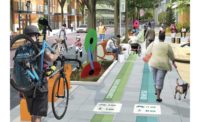Portland, Ore., voters may have the opportunity next fall to vote on more than $3 billion in regional projects spanning 13 transportation corridors in the city and surrounding counties.
A preliminary list of projects, currently under consideration by Metro, the regional government and planning organization, would be eligible for an estimated $2.1 billion in additional funding from local, state and federal sources, bringing the total potential investment in the region to more than $5.2 billion.
The plan, which must undergo a series of approvals before reaching the November 2020 ballot, includes projects already through the planning process that can be completed within seven years, according to the agency. Specific contributions to congestion relief, greenhouse gas reductions, safety, resiliency and economic growth also factored into the selection process.
"Taken together, the projects proposed in the staff recommendation would dramatically increase the reliability and accessibility of transit and improve safety for people walking and biking along some of the most dangerous and congested travel corridors in the Portland area,” says Andy Shaw, Metro’s director of government affairs and policy Development.
The largest investment, $975 million, would go toward upgrading the Southwest Corridor parallel to I-5, and includes an 11-mile extension of the MAX light rail line. The project, which would leverage nearly $1.5 billion in federal funding, would also include reconstruction of two 80-year old timber-supported trestle bridges to current seismic standards, street reconstruction to encourage economic development and provide safety improvements for cyclists and pedestrians and a new parking garage and bus hub at the extension’s south terminus station.
The plan also seeks to improve address maintenance needs, transit availability and improved access for cyclists and pedestrians in areas such as the 10-mile 82nd Avenue corridor, where a $370-million allocation would fund improved sidewalks, crossings and lighting, as well as a partial grade separation of a congested interchange near Portland’s airport. The 15.3-mile Tulatin Valley Highway corridor would receive $350 million for safety upgrades, complete street enhancements and planning longer term investments.
In Portland’s central downtown area, which is expected to receive nearly a third of the city’s long-term growth, the plan would provide $220 million for street reconstruction and pedestrian/cyclist access, as well as planning for a 3-mile light rail tunnel. The Burnside Bridge, a nearly century-old 1,300 bascule bridge spanning the Willamette River, would receive $150 million for seismic upgrades.
As Metro refines the proposed projects’ scope, cost and implementation schedule in the coming months, the agency’s leadership must also determine funding sources. Options include tapping regional property, payroll and sales taxes and increases to motor vehicle fees. Nor are planners counting on substantial federal support for potential light rail projects. Except for the Southwest Corridor, projects that would be eligible for New Starts funding are assumed to receive no more than a 30% match.
A final decision on the plan is due by next spring in order to be placed on the November 2020 ballot.




Post a comment to this article
Report Abusive Comment